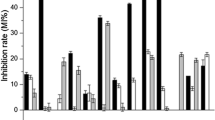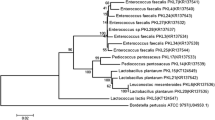Abstract
Isolation, identification and technological properties of halophilic lactic acid bacteria (HLAB) from olive samples which were collected from different places in Turkey were examined in the present work. According to the genetic analysis of the isolates, it was determined that 42 (%57.53) Lactobacillus plantarum, 20 (%27.39) Lactobacillus acidipiscis, 7 (%9.58) Enterococcus faecium, 2 (%2.73) Lactobacillus alimentarius, 1 (%1.36) Lactobacillus farciminis, 1 (%1.36) Lactobacillus namurensis. L. plantarum, L. alimentarius, L. farciminis and L. namurensis were able to tolerate 8% NaCl. Twenty-seven isolates showed lipolytic activity between 0.2 and 1.09 U ml−1. Thirty isolates had pectolytic activity as 3.24–5.29 U ml−1. A total of twelve L. acidipiscis, L. alimentarius, L. farciminis and L. plantarum strains showed positive decarboxylase activity by decarboxylating tyrosine. Results indicated that L. plantarum Z64A, Z64B, Z66A, Z83B, Z100A and L. acidipiscis Z112D showed high salt resistance, no biogenic amine production, low pectinolytic and low lipolytic activity. HLAB are dominant bacteria in the fermented foods containing high levels of salt. There are no many studies about the presence of HLAB in table olives and their technological properties. The present work showed that HLAB isolates of L. plantarum, L. acidipiscis and E. faecium were the predominant species found in table olives collected from the western part of Turkey. The selected strains which have high salt resistance, low pectinolytic and lipolytic activity are potentially good candidates as starter culture source in olive fermentations.

Similar content being viewed by others
References
Abriouel H, Benomar N, Lucas R, Gálvez A (2010) Culture-independent study of the diversity of microbial populations in brines during fermentation of naturally-fermented Aloreña green table olives. Int J Food Microbiol 144:487–496. https://doi.org/10.1016/j.ijfoodmicro.2010.11.006
Andersen HJ, Østdal H (1995) Partial purification and characterisation of lipase from Lactobacillus plantarum MF32. Food Chem 53:369–373
Argyri AA, Panagou EZ, Nychas GJE, Tassou CC (2014) Nonthermal pasteurization of fermented green table olives by means of high hydrostatic pressure processing. BioMed Res Int, Vol. 2014, Article ID 515623
Chamkha M, Sayadi S, Bru V, Godon JJ (2008) Microbial diversity in Tunisian olive fermentation brine as evaluated by small subunit rRNA—Single strand conformation polymorphism analysis. Int J Food Microbiol 122:211–215. https://doi.org/10.1016/j.ijfoodmicro.2007.11.052
Chammem N, Kachouri M, Mejri M, Peres C, Boudabous A, Hamdi M (2005) Combined effect of alkali pretreatment and sodium chloride addition on the olive fermentation process. Bioresour Technol 96:1311–1316
Dimou A, Panagou E, Stoforos NG, Yanniotis S (2013) Analysis of thermal processing of table olives using computational dynamics. J Food Sci 78:1695–1703
Ertürkmen P (2014) Beyaz peynir üretimi için starter kültür izolasyonu ve bu kültürlerin peynirin özellikleri üzerine etkisi, Yüksek Lisans Tezi. Süleyman Demirel Üniversitesi, Fen Bilimleri Enstitüsü, Isparta
Fleming HP, McFeeeters RF, Daeschel MA (1985) The lactobacilli, pediococci and leuconostocs: vegetable products. In: Gilliland SE (ed) Bacterial starter cultures for foods. CRC Press, New York, pp 97–117
Golomb BL, Morales V, Jung A, Yau B, Boundy-Mills KL, Marco ML (2013) Effects of pectinolytic yeast on the microbial composition and spoilage of olive fermentations. Food Microbiol 33:97–106
Gupta P, Upadhyay LSB, Shrivastana R (2011) Lipase catalyzed-transesterification of vegetable oils by lipolytic bacteria. Res J Microbiol 6:281–288. https://doi.org/10.3923/jm.2011.281.288
Harris LJ (1998) The microbiology of vegetable fermentations. In: Wood BJB (ed) Microbiology of fermented foods 1. Blackie Academic and Professional, London, pp 45–72
Heperkan D (2013) Microbiota of table olive fermentations and criteria of selection for their use as starters. Front Microbiol 4:143
Hurtado A, Reguant C, Bordons A, Rozès N (2012) Lactic acid bacteria from fermented table olives. Food Microbiol 31:1–8
Jaeger KE, Dijkstra BW, Reetz MT (1999) Bacterial biocatalysts: molecular biology, three-dimensional structures, and biotechnological applications of lipases. Annu Rev Microbiol 53:315–351
Joosten HMLJ, Northolt MD (1989) Detection, growth, and amine-producing capacity of lactobacilli in cheese. Appl Environ Microbiol 55:2356–2359
Kenneally PM, Leuschner RG, Arendt EK (1998) Evaluation of the lipolytic activity of starter cultures for meat fermentation purposes. J Appl Microbiol 84:839–846
Landeta G, Curiel JA, Carrascosa AV, Muñoz R, de las Rivas B (2013) Technological and safety properties of lactic acid bacteria isolate from Spanish dry-cured sausages. Meat Sci 95:272–280
Marquez MC, Ventosa A, Ruiz-Berraquero F (1986) A taxonomic study of heterotrophic halophilic and non- halophilic bacteria from a solar saltern. J Gen Microbiol 133:45–56
Marsilio V, Lanza B (1998) Characterisation of an oleuropein degrading strain of Lactobacillus plantarum. combined effects of compounds present in olive fermenting brines (phenols, glucose and NaCl) on bacterial activity. J Sci Food Agric 76:520–524
Montel MC, Masson F, Talon R (1998) Bacterial role in flavour development. Meat Sci 49:111–123
Morales F, Morales IJ, Hernandez CH (2011) Isolation and partial characterization of halotolerant lactic acid bacteria from two Mexican cheeses. Appl Biochem Biotechnol 164:889–905
Mourad K, Halima Z-K, Nour-Eddine K (2004) Isolation of lactic acid bacteria for its possible use in the fermentation of green algerian olives. Grasas Aceites 55:385–393
Nei M, Li WH (1979) Mathematical model for studying genetic variation in terms of restriction endonucleases. Proc Natl Acad Sci USA 76:5269–5273
Özay G, Borcakli M (1995) Effect of brine replacement and salt concentration on the fermentation of naturally black olives. Food Res Int 28:553–559
Patil RC, Murugkar TP, Shaikh SA (2012) Extraction of pectinase from pectinolytic bacteria isolated from carrot waste. Int J Phys Sci 3:261–266
Quintana MC, Garcia Garcia P, Fernandez AG (1999) Establishment of conditions for green table olive fermentation at low temperature. Int J Food Microbiol 51:133–143. https://doi.org/10.1016/S0168-1605(99)00123-3
Satomi M, Kimufu B, Mizoi M, Sato T, Fujii T (1997) Tetragenococcus muriaticus sp. nov., a new moderately halophilic lactic acid bacterium isolated from fermented squid liver sauce. Int J Syst Bacteriol 47:832–836
Sudagidan M, Yenidunya AF, Gunes H (2005) Identification of staphylococci by 16S internal transcribed spacer rRNA gene restriction fragment length polymorphism. J Med Microbiol 54:823–826
Tepe O, Dursun AY (2014) Exo-pectinase production by Bacillus pumilus using different agricultural wastes and optimizing of medium components using response surface methodology. Environ Sci Pollut Res Int 21(16):9911–9920. https://doi.org/10.1007/s11356-014-2833-8
Thapa N, Pal J, Tamang JP (2006) Phenotypic identification and technological properties of lactic acid bacteria isolated from traditionally processed fish products of the Eastern Himalayas. Int J Food Microbiol 107:33–38
Tofalo R, Schirone M, Perpetuini G, Angelozzi G, Suzzi G, Corsetti A (2012) Microbiological and chemical profiles of naturally fermented table olives and brines from different Italian cultivars. Anton Leeuw Int J G 102:121–131. https://doi.org/10.1007/s10482-012-9719-x
Torimiro N, Okonji RE (2013) A comparative study of pectinolytic enzyme production by Bacillus species. Afr J Biotechnol 12:6498–6503
Uchida M, Miyoshi T, Yoshida G, Niwa K, Mori M, Wakabayashi H (2014) Isolation and characterization of halophilic lactic acid bacteria acting as a starter culture for sauce fermentation of the red alga Nori (Porphyra yezoensis). J Appl Microbiol 116:1506–1520
Udomsil N, Rodtong S, Tanasupawat S, Yongsawatdigul J (2010) Proteinase-producing halophilic lactic acid bacteria isolated from fish sauce fermentation and their ability to produce volatile compounds. Int J Food Microbiol 141:186–194
Weisburg WG, Barns SM, Pelletier DA, Lane DJ (1991) 16S Ribosomal DNA amplification for phylogenetic study. J Bacteriol 173:697–703
Zajc J, Kogej T, Galinski EA, Ramos J, Cimerman NG (2014) Osmoadaptation strategy of the most halophilic fungus, wallemiaichthyophaga, growing optimally at salinities above 15% NaCl. Appl Environ Microbiol 80:247–256
Acknowledgements
The present was supported by Mehmet Akif Ersoy University, BAP Commission under the project no of 0240-YL-14 and TUBITAK 2210-National Scholarship Programme for MSc Students.
Author information
Authors and Affiliations
Corresponding author
Ethics declarations
Conflict of interest
The authors declare that they have no conflict of interest.
Additional information
Publisher's Note
Springer Nature remains neutral with regard to jurisdictional claims in published maps and institutional affiliations.
Rights and permissions
About this article
Cite this article
Yalçınkaya, S., Kılıç, G.B. Isolation, identification and determination of technological properties of the halophilic lactic acid bacteria isolated from table olives. J Food Sci Technol 56, 2027–2037 (2019). https://doi.org/10.1007/s13197-019-03679-9
Revised:
Accepted:
Published:
Issue Date:
DOI: https://doi.org/10.1007/s13197-019-03679-9




